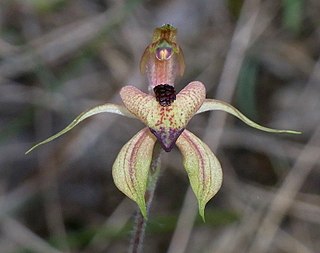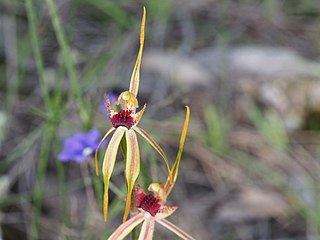Caladenia robinsonii, commonly known as the Frankston spider orchid is a plant in the orchid family Orchidaceae and is endemic to Victoria. It is a ground orchid with a single hairy leaf and one or two red and creamy-yellow flowers with dark red glandular tips on the sepals. In 2010 only about forty specimens of this plant, growing in a single population were known.

Caladenia cardiochila, commonly known as thick-lipped spider-orchid, fleshy-lipped caladenia and heartlip spider-orchid, is a plant in the orchid family Orchidaceae and is endemic to Victoria and South Australia. It is a ground orchid with a single hairy leaf and one or two yellowish-green, red-striped flowers on a thin, wiry stem.

Caladenia actensis, commonly known as the Canberra spider orchid, is a plant in the orchid family Orchidaceae and is endemic to the Australian Capital Territory. It has a single leaf and usually only one greenish flower with red markings and only occurs in three small populations.

Caladenia fitzgeraldii, commonly known as Fitzgerald's spider orchid, is a plant in the orchid family Orchidaceae and is endemic to New South Wales and the Australian Capital Territory. It is a ground orchid with a single hairy leaf and usually only one greenish-yellow and red flower.

Caladenia gladiolata, commonly known as small bayonet spider orchid, smelly socks or simply bayonet orchid is a plant in the orchid family Orchidaceae and is endemic to South Australia. It is a ground orchid with a single hairy leaf and one or two yellowish or brownish flowers with red stripes and unusual tips on the sepals and petals.
Caladenia hoffmanii, commonly known as Hoffman's spider orchid is a species of orchid endemic to the south-west of Western Australia. It has a single, hairy leaf and one or two, greenish-yellow, red and white flowers which have a greenish-yellow labellum with a red tip. It is distinguished from the Pingaring spider orchid by small differences in the labellum and more northerly distribution.

Caladenia longiclavata, commonly known as the clubbed spider orchid is a species of plant in the orchid family, Orchidaceae and is endemic to the south-west of Western Australia. It is a widespread and common orchid with a single, hairy leaf and one or two greenish-yellow, white and red flowers and which grows in the area between Perth and Albany.

Caladenia montana, commonly known as the mountain spider orchid is a plant in the orchid family Orchidaceae and is endemic to New South Wales, Victoria and the Australian Capital Territory. It is a ground orchid with a single leaf and a single greenish-cream to cream flower, sometimes with reddish markings. It only grows in high montane forests.
Caladenia oreophila is a plant in the orchid family Orchidaceae and is endemic to south-eastern Australia. It is a ground orchid with a single leaf and a single greenish-cream flower with pale red stripes a red labellum with a greenish-cream base.
Caladenia osmera is a plant in the orchid family Orchidaceae and is endemic to south-eastern Australia. It is a ground orchid with a single leaf and one or two greenish-cream flowers with pink stripes and which has a sharp odour resembling burnt plastic.

Caladenia parva is a plant in the orchid family Orchidaceae and is endemic to south-eastern Australia. It is a ground orchid with a single leaf and one or two green flowers with red stripes along the sepals and petals.
Caladenia richardsiorum, commonly known as the little dip spider orchid, Richards' spider orchid or robe spider orchid, is a plant in the orchid family Orchidaceae and is endemic to South Australia. It is a ground orchid with a single erect, hairy leaf and usually only one yellowish-green flower. It is similar to the endangered Mellblom's spider orchid but has a much larger leaf and the petals lack glandular tips.

Caladenia verrucosa, commonly known as the mallee spider orchid, is a plant in the orchid family Orchidaceae and is endemic to south-eastern Australia. It is a ground orchid with a single, hairy leaf and usually only one greenish-yellow and red flower.

Caladenia septuosa, commonly known as the Koppio spider orchid, is a plant in the orchid family Orchidaceae and is endemic to South Australia. It is a ground orchid with a single erect, sparsely hairy leaf and usually only one greenish-cream flower with red stripes along the sepals and petals.
Caladenia stellata, commonly known as the starry spider orchid is a plant in the orchid family Orchidaceae and is endemic to south-eastern Australia. It is a ground orchid with a single, hairy leaf and usually only one greenish-cream flower with red markings.
Caladenia thysanochila, commonly known as the peninsula spider orchid or fringed spider-orchid, is a plant in the orchid family Orchidaceae and is endemic to Victoria. It is a ground orchid with a single hairy leaf and a single bright white to pale pinkish flower. Only two flowers have been seen and the species is thought to be extinct.
Caladenia branwhitei, commonly known as the Bethungra spider orchid, is a plant in the orchid family Orchidaceae and is endemic to southern New South Wales. It has a single dull green leaf and one or two, usually dark red to maroon-coloured flowers. It is only known from three areas near Bethungra where it grows in ironbark forest.
Caladenia rileyi, commonly known as the Gillenbah spider orchid, is a plant in the orchid family Orchidaceae and is endemic to New South Wales. It is a ground orchid with a single leaf and a single yellowish-green and red flower.
Caladenia subtilis, commonly known as the delicate spider orchid, is a species of orchid endemic to New South Wales. It has a single leaf and a single greenish to cream-coloured flower with dark red tips on the sepals.
Caladenia xanthochila, commonly known as the yellow-lip spider orchid is a plant in the orchid family Orchidaceae and is endemic to southern Australia. It is a rare ground orchid with a single leaf and usually only one pale greenish-yellow flower. Only a few plants are known from Victoria and South Australia.


















